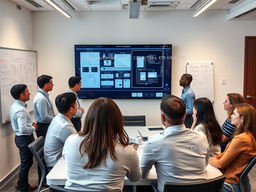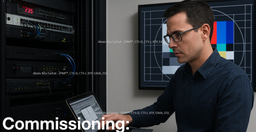AV Subsystem Spotlight: Interactive Boards – The Convergence of Display, Collaboration and Networked AV

Following a recent post outlining the broad and diverse landscape of the AV industry, several readers and connections reached out asking for a deeper understanding of specific subsystems, particularly Interactive Boards. This article may serves as a comprehensive technical exploration of Interactive Boards as a crucial AV subsystem, examining their architecture, components, use cases, integration methods and role in modern audiovisual design.
1. Introduction to Interactive Boards.
Interactive Boards, also referred to as Interactive Flat Panels (IFPs) or Interactive Display Systems (IDS), are advanced display solutions that integrate touchscreen capabilities, embedded computing and AV hardware into a unified platform. They are designed to support multi-user engagement, real-time content manipulation, remote collaboration and integration with AV and IT infrastructures.
From classrooms to corporate boardrooms, control centers to training facilities, Interactive Boards have become central components in modern AV environments. Their ability to merge traditional whiteboarding with digital interactivity enables enhanced user experiences and streamlined workflows.
2. Core Components and Technologies.
An Interactive Board is a convergence of multiple subsystems working together to provide a seamless user experience. The primary components include:
2.1 Display Technology:
-
Resolution: Common resolutions include Full HD (1920x1080), 4K UHD (3840x2160) and in high-end systems, 8K. The higher the resolution, the greater the clarity for content such as architectural schematics, engineering models or video conferencing feeds.
-
Panel Type: Most Interactive Boards use LED-backlit LCD panels, though OLED is emerging in premium solutions. Brightness levels typically range from 350 to 500 nits ( or more) , with anti-glare coatings and tempered glass for durability.
-
Size Range: Panels are generally available in sizes ranging from 55” to 98”, depending on room type and application.
2.2 Touch Interface:
-
Touch Technology:
-
Infrared (IR): Cost-effective and widely used. Supports multi-touch but has limitations in edge accuracy.
-
Capacitive Touch: Offers higher precision and responsiveness. Common in premium models.
-
InGlass and EMR (Electromagnetic Resonance): Used in systems requiring precision drawing or stylus input, such as design applications.
-
-
Touch Points: Professional-grade panels support 10 to 40 touch points simultaneously, allowing multiple users to interact with the display at once.
2.3 Embedded Computing:
-
Operating System: Most Interactive Boards ship with dual operating systems—typically Android for lightweight operations and Windows (via slot-in PC modules or OPS) for enterprise-level applications.
-
Hardware Specs:
-
CPU: Quad-core to Octa-core ARM for Android or Intel i5/i7/i9 for Windows modules.
-
RAM: 4GB to 16GB.
-
Storage: Ranges from 32GB eMMC to 512GB SSD depending on OS and configuration.
-
-
Applications: Preloaded with whiteboarding apps, screen sharing tools, web browsers, document viewers and app marketplaces.
2.4 AV Hardware Integration:
-
Cameras: Integrated 1080p or 4K cameras for video conferencing, sometimes with auto-framing and facial recognition.
-
Microphones: MEMS or beamforming mic arrays for far-field voice pickup.
-
Speakers: Front-facing stereo or 2.1-channel audio systems capable of producing up to 40W output.
-
I/O Ports: HDMI, DisplayPort, USB (Type-A/C), RS232, RJ45, audio in/out and sometimes SD card slots.
2.5 Connectivity and Network Integration:
-
Wireless Protocols: Supports Wi-Fi, Bluetooth, Miracast, AirPlay and Chromecast for BYOD environments.
-
Wired Connectivity: Gigabit Ethernet, PoE (in some models) and direct display/data cabling.
-
Remote Management: Cloud-based platforms for firmware updates, user management, device monitoring and remote troubleshooting.
3. System Architecture and AV Integration.
3.1 AV-over-IP Compatibility:
Modern Interactive Boards support networked AV protocols, allowing them to function as endpoints or control interfaces in AV-over-IP ecosystems. Integration with standards like Dante AV, NDI and SDVoE allows for:
-
Multizone content distribution.
-
Real-time audio/video routing.
-
Centralized media playback control.
3.2 Control Systems Integration:
Interactive Boards can be integrated into enterprise control systems such as Crestron, AMX, Extron or Kramer through:
-
IP API or RS232 control.
-
Embedded control clients (e.g., Crestron XiO Cloud).
-
Scheduled events and triggers for automation (e.g., power-on/off, input switching, room presets).
3.3 Unified Communications and Collaboration:
Interactive Boards serve as all-in-one UC terminals, integrating directly with platforms like:
-
Microsoft Teams Rooms (MTR).
-
Zoom Rooms.
-
Google Meet Hardware.
-
Webex Room Devices.
They support calendar integration, one-touch join, screen annotation and camera/mic control, reducing the need for separate conferencing hardware.
4. Application Environments.
4.1 Corporate:
Interactive Boards are widely used in huddle rooms, executive boardrooms and training centers. Key use cases include:
-
Digital whiteboarding and brainstorming.
-
Screen sharing during presentations.
-
Interactive video conferencing with remote participants.
-
Agile project management using tools like Miro, Microsoft Whiteboard or Jamboard.
4.2 Education:
In education, Interactive Boards replace traditional whiteboards and projectors, offering:
-
Interactive lessons with multimedia content.
-
Simultaneous student collaboration.
-
LMS integration (e.g., Google Classroom, Canvas).
-
Remote teaching via conferencing platforms.
Advanced systems may include student response integration, lesson recording and cloud syncing for homework sharing.
4.3 Command and Control Centers:
Interactive Boards are also used in high-availability environments such as:
-
Security operations centers (SOCs).
-
Network operations centers (NOCs).
-
Emergency response control rooms.
Here, they serve as:
-
Interactive data visualization surfaces.
-
Touch-enabled scenario planning and map manipulation tools.
-
Multi-source input displays with KVM integration.
5. Design and Implementation Considerations.
5.1 Display Placement and Ergonomics:
-
Height and Tilt: Must adhere to ADA accessibility standards where applicable. Mounting height should accommodate both standing and seated users.
-
Glare Management: Use of anti-reflective coatings, ambient light sensors and room lighting design is critical.
-
Viewing Angles: 178° H/V is standard, but placement should ensure optimal visibility across seating zones.
5.2 Network Design:
-
Wired Connectivity: Preferred for stability, especially in environments with high wireless traffic.
-
VLAN Segmentation: UC traffic, management and screen sharing should be segregated for security and performance.
-
Security: Secure access policies, firmware update validation and remote lockdown capabilities are essential for enterprise deployment.
5.3 Power and Cooling:
-
Power Requirements: Most panels consume 150W–300W, depending on size and backlight brightness.
-
Thermal Management: Ventilation and fanless operation (for quiet rooms) should be considered during enclosure and mounting.
6. Remote Management and Monitoring.
Enterprise-scale deployments require centralized device management platforms capable of:
-
Remote monitoring (online/offline status, usage stats).
-
Firmware deployment and rollback.
-
User profile synchronization.
-
Alerts for unauthorized access or performance degradation.
Vendors often provide proprietary solutions or integrate with third-party AV/IT management platforms such as Barco Overture, Crestron Fusion or Google Admin Console (for ChromeOS-based boards).
7. Interoperability and Standards Compliance.
For broad adoption and easy integration, Interactive Boards should support:
-
HDMI CEC for basic AV device control.
-
HDCP 2.2/2.3 compliance for content protection.
-
UVC/UAC standards for webcam/mic support across UC platforms.
-
EDID management for display detection.
-
Support for IT standards like SNMP, LDAP, SSO and Active Directory.
8. Market Landscape and Technology Trends.
8.1 Key Manufacturers:
Some leading brands in the interactive board space include ( though there are certainly other worthy brands as well ):
-
SMART Technologies.
-
Promethean.
-
ViewSonic.
-
BenQ.
-
Samsung Flip.
-
LG CreateBoard.
-
Microsoft Surface Hub.
-
Cisco Webex Board.
-
Avocor.
-
Newline.
- Epson.
Each offers unique feature sets tailored for corporate, education or specialized applications.
8.2 Trends and Innovations:
-
AI-enhanced Collaboration: Voice-to-text transcription, AI-based meeting summaries and facial recognition attendance.
-
Edge Processing: Boards are becoming more powerful, reducing reliance on external PCs or cloud platforms.
-
Cloud Native Solutions: Content sync, remote access and whiteboarding are becoming cloud-first.
-
Interactivity Beyond Touch: Gesture control, pen pressure sensitivity and haptic feedback are emerging.
-
Sustainability Focus: Energy-efficient LED backlighting, recycled materials and low-power standby modes.
9. Challenges and Best Practices.
9.1 Deployment Challenges:
-
Network Bottlenecks: Especially in wireless BYOD-heavy environments.
-
User Training: Staff and students need onboarding for effective use.
-
Software Updates: Timely and secure updates are necessary to prevent vulnerabilities.
-
Device Sprawl: Without centralized management, tracking multiple boards becomes cumbersome.
9.2 Best Practices:
-
Involve AV/IT integration early in architectural design.
-
Conduct site surveys for lighting, acoustics and network readiness.
-
Use enterprise-grade boards with documented support cycles.
-
Standardize platforms across locations for easier management and support.
-
Provide user training and quick-reference guides to encourage adoption.
Finally, Interactive Boards are no longer a niche or “nice-to-have” component in AV systems—they are an integral AV subsystem that enables digital transformation in how teams teach, present, meet and collaborate. The best deployments combine high-quality hardware, well-architected AV integration and secure, scalable software ecosystems.
As AV converges with IT and the demand for seamless hybrid collaboration increases these days, the importance of Interactive Boards in AV system design will continue to grow. Understanding their capabilities, integration paths and technical constraints is essential for AV consultants, system designers, IT managers and facilities planners alike.
By viewing Interactive Boards not merely as display devices, but as collaboration infrastructure, AV professionals can deliver smarter, more connected environments that truly enhance user engagement and productivity.
-
Xchange Advocates are recognized AV/IT industry thought leaders and influencers. We invite you to connect with them and follow their activity across the community as they offer valuable insights and expertise while advocating for and building awareness of the AV industry.
Recommended Content
LetsTalkAVbyAlexis Series: Episode 4 : Design Begins With People: Engineering AV Systems Around Real End-User Requirements

LetsTalkAVbyAlexis Series : Episode 2: Network & AV Convergence (AVoIP)







Please sign in or register for FREE
If you are a registered user on AVIXA Xchange, please sign in